The best Baldur's Gate 3 builds for Patch 8 and beyond
Why stick with just one class when you could have, like, four?
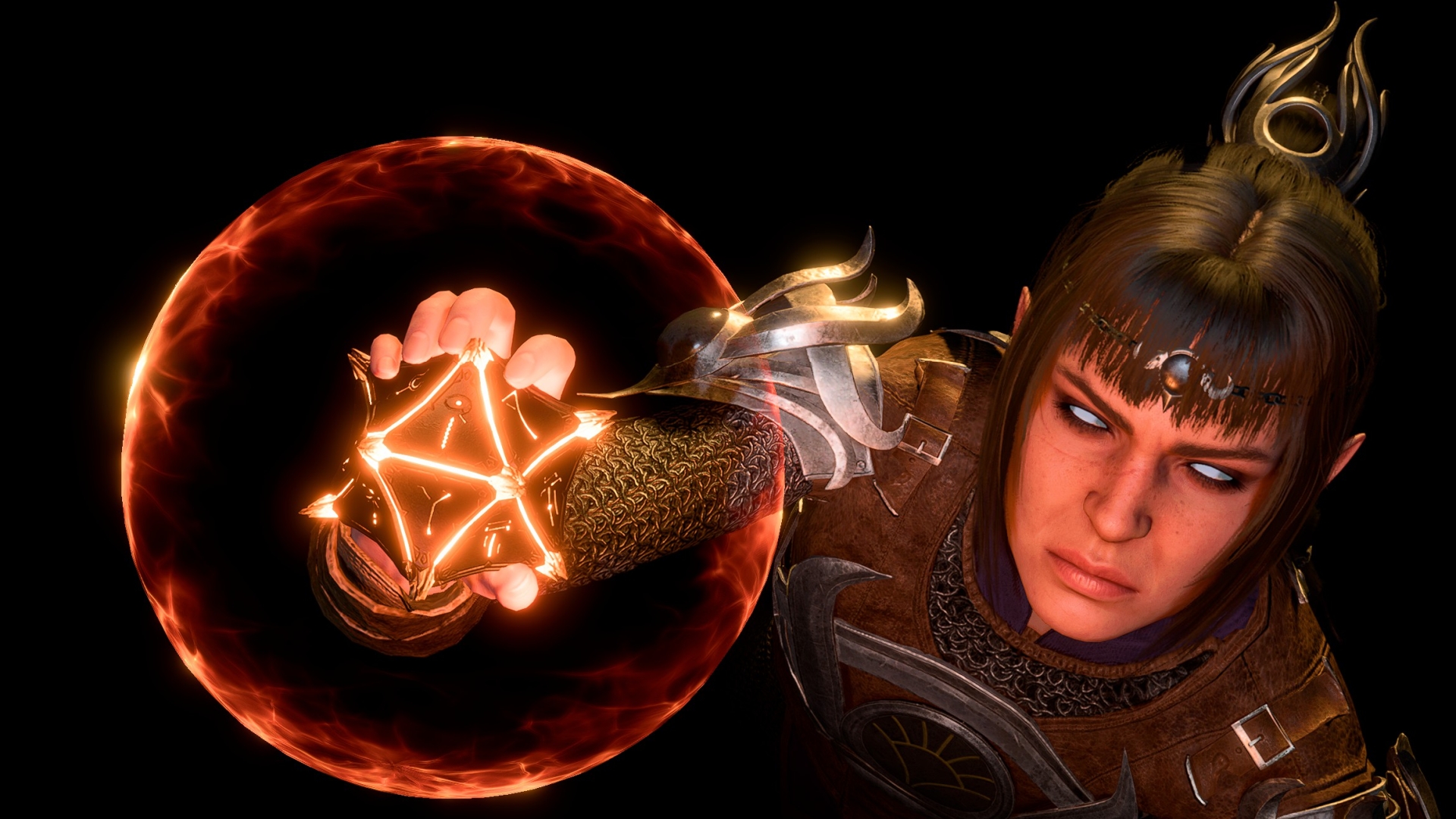
- How to multiclass
- Patch 8 Build: Pure Hexblade is just that good
- Patch 8 Build: Bladesinging Wizardin / Classic Death Knight
- Patch 8 Build: Mostly Pure Arcane Archer
- Patch 8 Build: Hexbuckler
- Patch 8 Build: Giant Barbarian Rainbow Thrower
- Circle of Stars Spirit Guardians Death Cleric
- Sorcerer Paladin (Sorcadin)
- Hand Crossbow Gunslinger Bard
- Master Martial Artist
- Sneaky Assassin Guy Classic
- Blackguard Warlock Smiter
- Paladin Batman
- Olympic Shotputter Barbarian
- Swashbuckling Duelist Bardadin
There are people who have played Baldur's Gate 3 more than me, but I feel pretty good about my record: 440 hours and counting, one Honour mode clear, two on Tactician, and I don't know how many failed or dropped runs. On top of that, I've got a healthy diet of r/BG3builds posts, YouTube build videos, and notebooks full of little guys I want to take into the game.
With the release of Patch 8's 12 new subclasses, I'm back at it again channeling my unhealthy fixation on RPG powergaming into my job. Overview and starting stats for the Patch 8 guys are ready to go, with recommended gear for each to come soon.
In the first part of this guide, I'll go over the basic rules and best practices of multiclassing, but you can skip to the second section for a collection of builds inspired by my own experience, as well as the most diabolical setups I've seen on YouTube.
How to multiclass
Each time you level up in Baldur's Gate 3, you can choose any of its 12 classes to progress in. Baldur's Gate 3 has actually removed tabletop attribute restrictions from multiclasses, so your only restriction is whether the choice is worthwhile or not. There's even an achievement, "Jack of All Trades," awarded by taking one level of each class on the same character without respeccing.
Baldur's Gate 3 has a relatively low level cap of 12, and multiclassing can delay or lock you out of endgame abilities. How much of a loss this is depends on the class—I've yet to run into a spellcasting-focused multiclass that I find more compelling than just sticking to the same caster for all twelve levels.
A lot of key bonuses are also tied to the level of your individual classes as opposed to your overall level. For example, you get an "ASI" or feat/attribute bonus every four levels of a class—a level 8 fighter would have two ASIs, while a 5 Fighter/3 Rogue would have just one.
Other level milestones to keep in mind:
Keep up to date with the most important stories and the best deals, as picked by the PC Gamer team.
- Extra Attack: Fighters, Barbarians, Rangers, Monks, and Paladins get a second full attack per turn at level 5. Blade/Valour Bards get this at level 6. Pact of the Blade Warlocks get a special Blade Pact Extra Attack at level 5 that does stack with the normal Extra Attack (usually it's just one and done). Extra Attack is a priority ability you don't want to delay more than one or two levels. As a note: Fighters get Improved Extra Attack (for three attacks per round) at level 11, which makes a pure Fighter very competitive with martial multiclasses.
- Subclass: Most classes let you choose a subclass at level 3 (your Bard college, for example). This is often, but not always, the minimum number of levels you want to hit in a second or third class. Most spellcasters, and also Paladins, choose their subclass at level 1.
- Spell levels: Full casters gain new spell levels and spell slots every odd class level. Additionally, spellcaster/spellcaster multiclasses have a shared pool of spell slots, removing a major disadvantage of this kind of character in older versions of D&D. A Wizard 4/Cleric 3 can only cast level 2 spells from each class, but will have a large number of spell slots to devote to each, with their Cleric spells able to go in Wizard slots and vice versa.
- Proficiencies: Classes gain fewer weapon, skill, and saving throw proficiencies when chosen later on than at level 1. It can sometimes be beneficial to choose a class like Fighter or Rogue at level 1 for their excellent martial/skill proficiencies, even if they aren't going to be your main class focus.
- Attributes: The highest you can raise an Attribute at character creation is 17 for a +3 bonus to its applications. You get another +1 every even level, to a max of +5 at 20 in a stat. One strategy is to start with one score at 17, another at 15, and raising both with an ASI at level 4. You can use Auntie Ethel's Hair (by either siding with her or intimidating her) get a permanent +1 to an attribute. You can also get a permanent +2 to Strength in Act 2 through Araj Obladra, and a +2 to any attribute in Act 3 through the Mirror of Loss.
Patch 8 Build: Pure Hexblade is just that good
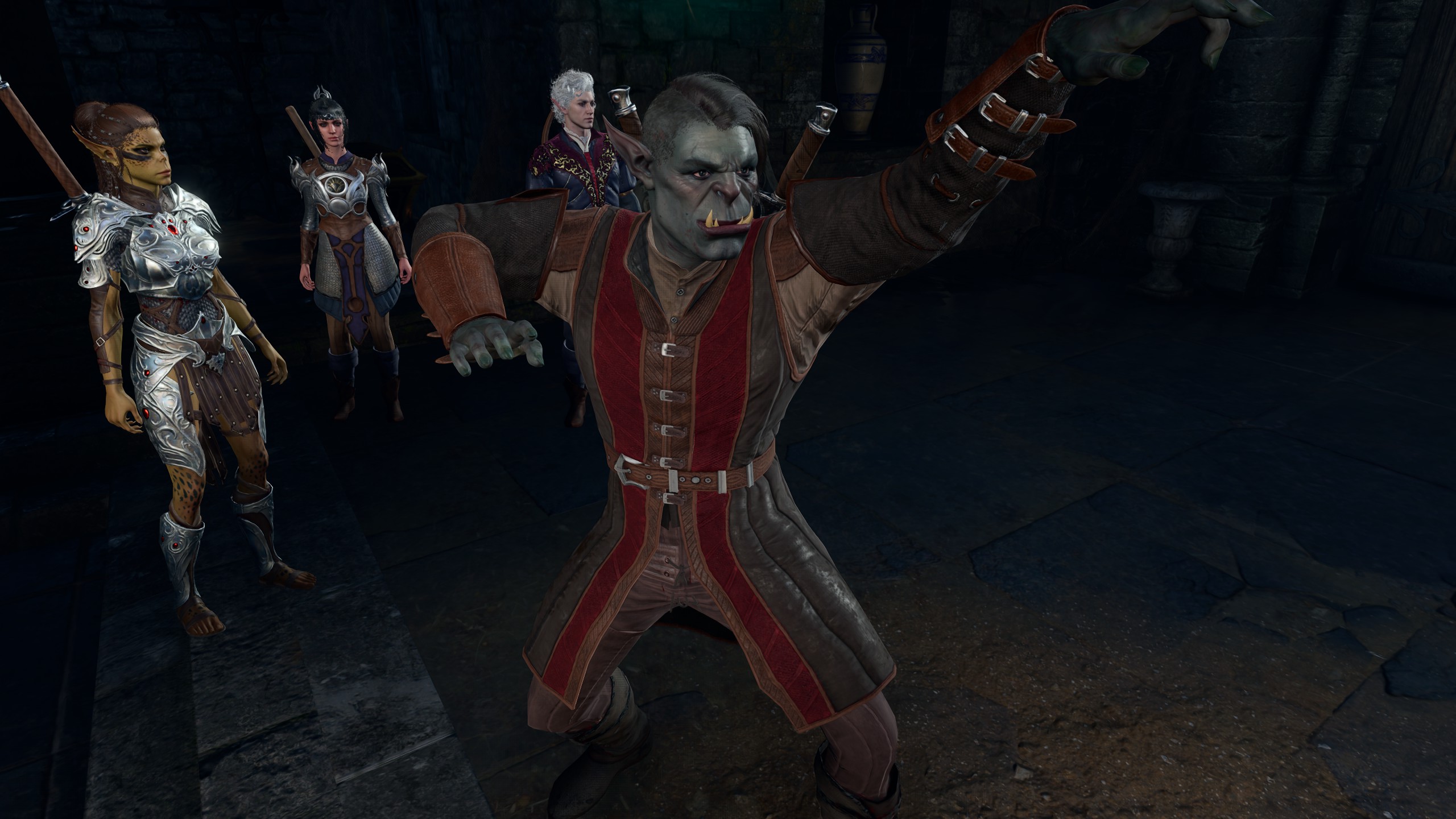
Hexblade Warlock 12
I originally figured a Hexblade multiclassed with Champion Fighter would be the way to go, but full level-12 Warlocks actually get a lot of goodies that make going the distance really worth it.
The crux of the build is Shadow Blade, a revamped spell in Patch 8 that summons a 2d8 psychic damage short sword you can use until long rest, no strings attached—and you can up-cast it for a 3d8 and max 4d8 version of the sword.
Hexblade's Charisma-based melee attacking and increased critical threat range all lend itself to juicy damage with Shadow Blade, but I've also been really enjoying its flexibility: Pair with the Potent Robe, Devil Sight, Darkness, and Agonizing Blast for a still quite strong Eldritch Blaster against ranged foes or pesky psychic damage-immune enemies.
The Devil Sight/Darkness combo—you can see enemies, but they can't see you in your little darkness cloud—is also plenty strong in melee as well. Further, Hexblades' Accursed Spectres (unlocked at level 6) are surprisingly powerful, and there is no limit to how many you can summon per round.
The Potent Robe bonuses also synergize with Booming Blade, which we've got no reason not to just spam every round with our summoned Shadow Blade. Round out with the Resonance Stone to double our psychic damage from Shadow Blade, and we've got a master of all spellsword who's deadly from any range. I recommend going all the way to level 12 to acquire Lifedrinker, a final Warlock invocation that adds your Charisma bonus as necrotic damage to all attacks, on top of your other stacking sources of Charisma to damage.
Starting Stats:
- Strength: 8
- Dexterity: 16
- Constitution: 14
- Intelligence: 8
- Wisdom: 10
- Charisma: 17
Leveling Order:
- Hexblade 1
- Hexblade 2 - Agonising Blast, Beast Speech
- Hexblade 3 - Pact of the Blade, Shadow Blade
- Hexblade 4 - Feat: Savage Attacker
- Hexblade 5 - Pact Extra Attack, Devil Sight (pair with Darkness cast on self)
- Hexblade 6 - Accursed Specter
- Hexblade 7 - Beguiling Influence
- Hexblade 8 - Feat: Charisma +2
- Hexblade 9 - Armour of Shadows
- Hexblade 10
- Hexblade 11
- Hexblade 12 - Lifedrinker
Act 1 Gear
- Knife of the Undermountain King
- Spidersilk Armour
- Disintegrating Night Walkers
- Diadem of Arcane Synergy
- Bow of Awareness
- Auntie Ethel's Hair
- Bracers of Defence (Save for later)
- Ring of Protection
Act 2 Gear
Act 3 Gear
Patch 8 Build: Bladesinging Wizardin / Classic Death Knight
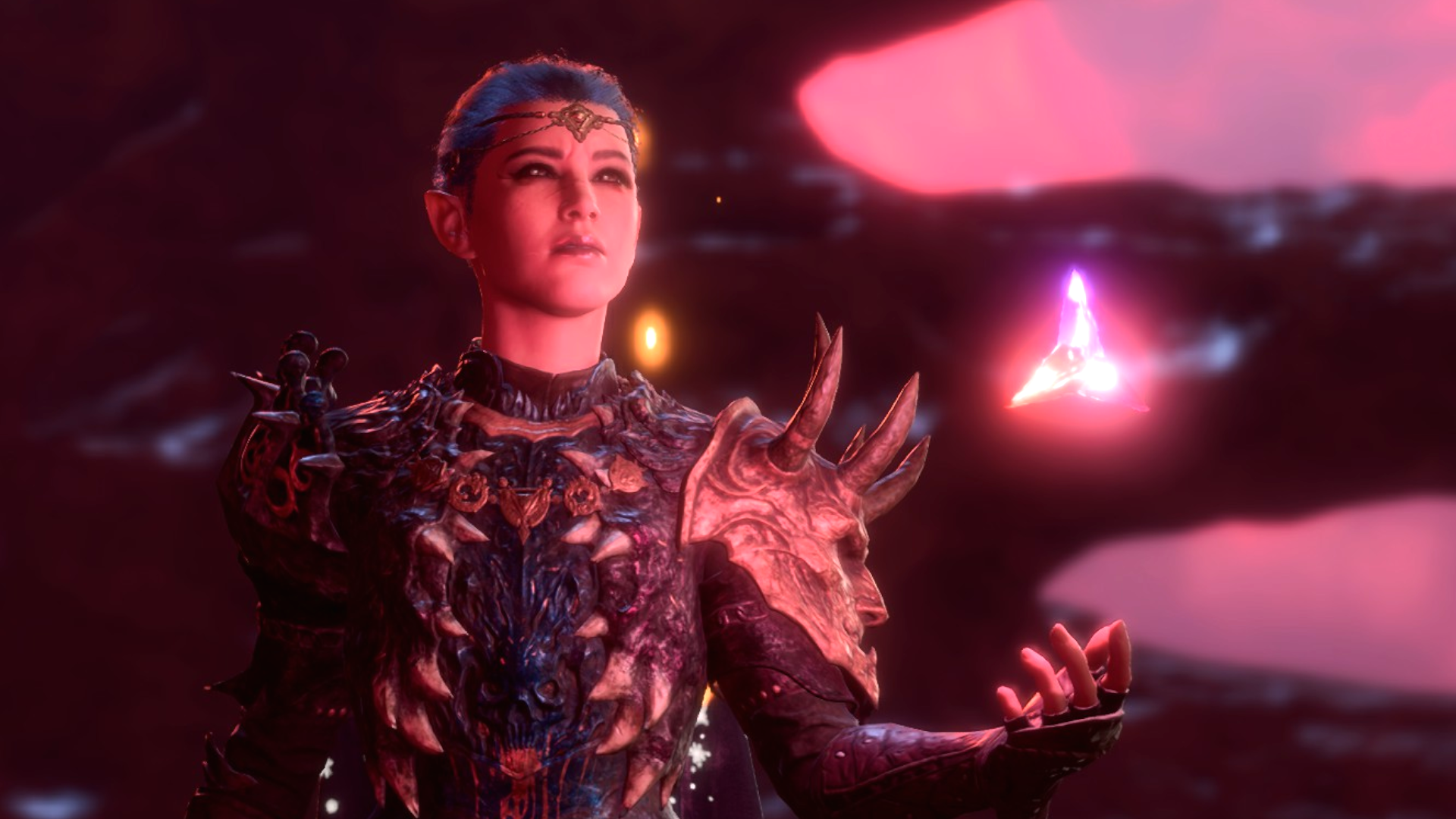
Bladesinging Wizard 10 / Oath of the Crown Paladin 2
The more I've experimented with the Wizard's new Bladesinging subclass, the more I love it. I've based my build here on these guides by c4b-BG3 and Bravest_Coward on the BG3Builds subreddit.
If Hexblade is more of an all-out, pure damage, edgelord sort of battlemage, Bladesingers are tankier and more versatile, while still putting out team-carrying levels of damage. The playstyle's stand and fight potential and reliance on buffs like Haste and Mirror Image actually reminds me a lot of the classic Fighter/Mage or, ugh, Kensai/Mage from Baldur's Gate 2.
Between the Bladesinging ability, spells like Haste and Mirror Image, and Constitution (i.e. Concentration) saving throw-boosting gear, Bladesinger is a rare BG3 class that doesn't necessarily have to cheese surprise rounds to survive on Honour Mode.
Bladesinger can't use Intelligence as a melee modifier like Hexblades can Charisma, so you've got to split your stats between Dexterity and Intelligence. A balance of 20 Dex and 18 Int using bonuses from an ASI, Auntie Ethel's Hair, and the Mirror of Loss is what I plan on going for in the endgame.
Weapon-wise, combining Great Weapon Fighting with Phalar Aluve could be a fun, thematic way to play the Bladesinger, but the beastly combo of Shadow Blade, Resonance Stone, and Belm is hard to pass up.
I haven't had a chance to test this in Patch 8, but I've heard that Act 3's Elven Chain armor does not actually count as armor in the game logic due to the unique way it was implemented, so it can stack with the Bracers of Defence, Mage Armour, and still allow for Bladesinging, making for an insanely high Armor Class to dodge almost every attack.
A pure 12 levels of Bladesinger would be plenty strong, and can effectively already smite enemies for free with Booming Blade, but grabbing those final two levels of Paladin to open up nasty spellslot smiting is just too good to pass up.
Starting Stats:
- Str: 8
- Dex: 17
- Con: 14
- Int: 16
- Wis: 10
- Cha: 8
Leveling Order:
- Wizard 1
- Bladesinger 2
- Bladesinger 3
- Bladesinger 4, Feat: Savage Attacker OR Great Weapon Master (Shadow Blade / Phalar Aluve respectively)
- Bladesinger 5
- Bladesinger 6, Extra Attack
- Bladesinger 7
- Bladesinger 8, Feat: +2 Dexterity
- Bladesinger 9
- Oath of the Crown 1
- Oath of the Crown 2, Divine Smite
- Bladesinger 10, Song of Defence
Key Spells:
- Cantrips: Booming Blade
- Level 1: Shield, Expeditious Retreat, Longstrider, Mage Armour, Magic Missile
- Level 2: Shadow Blade, Blur, Mirror Image, Hold Person, Invisibility, Misty Step, Detect Thoughts
- Level 3: Haste, Animate Dead, Fireball
- Level 4: Greater Invisibility, Conjure Minor Elemental, Ice Storm
- Level 5: Cone of Cold, Conjure Elemental, Hold Monster
Act 1 Gear
- Ring of Protection
- Strange Conduit Ring
- Diadem of Arcane Synergy
- Wondrous Gloves
- Bracers of Defence (save for later)
- Knife of the Undermountain King
- Disintegrating Night Walkers
- Bow of Awareness
- Phalar Aluve
- Auntie Ethel's Hair
Act 2 Gear
Act 3 Gear
- Elegant Studded Leather
- Elven Chain
- Belm
- Band of the Mystic Scoundrel
- Amulet of Greater Health
- The Dead Shot
Patch 8 Build: Mostly Pure Arcane Archer
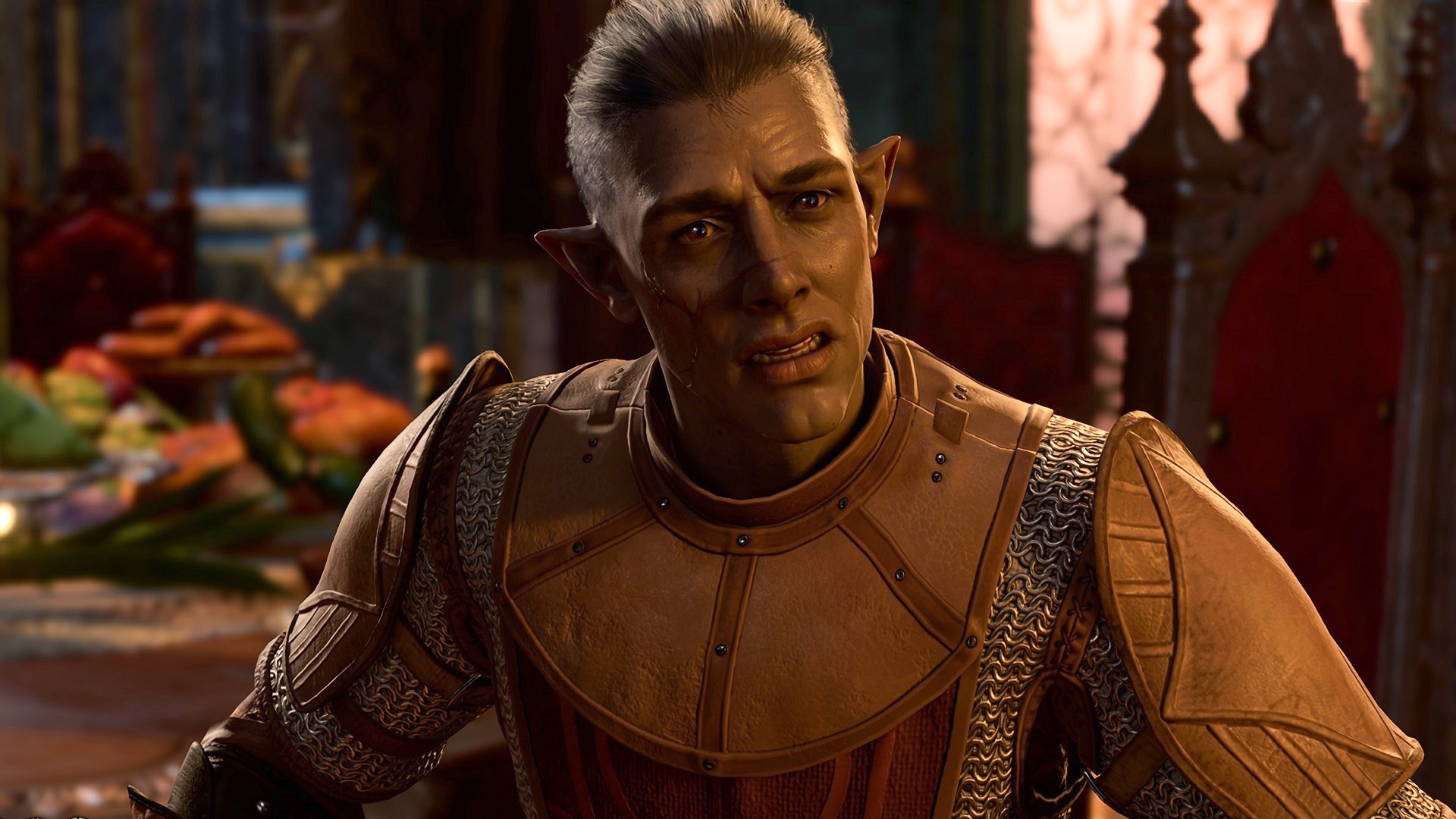
Arcane Archer 11 / War Priest 1
Arcane Archer is one of my low key favorites of the Patch 8 lineup for a few reasons, but mostly because I'm a big fan of the class fantasy dating back to its D&D 3E incarnation as a prestige class.
But it's also nothing to sneeze at in BG3. AA plays pretty similar to a ranged Battlemaster, one of the most simple but effective builds in Baldur's Gate 3. The Battlemaster benefits from their Superiority Die increasing in potency at higher level, being able to use their Maneuvers in melee as well as ranged, and not having to worry about Intelligence—the saves for AA's arrows all depend on your Int stat. Arcane Archer, meanwhile, has access to more powerful effects, and can eventually use their arrows more times before having to Short Rest.
They're both extremely effective, so your choice between the two for the optimal BG3 longbowman is pretty much a matter of taste, but I really, really dig the Arcane Archer. By far the most notable magic arrow is Banishing Arrow, which sends the target to the Shadow Realm for two rounds a la the level four spell Banish.
Which basically means Arcane Archers get access to a level four spell (unlocked at character level seven) at character level three—that's insanely powerful! Other arrows I've enjoyed are Shadow Arrow (DPS against boss enemies and blind them for advantage), Grasping Arrow (potentially lingering DPS), and Piercing Arrow (situationally powerful AOE).
The single dinky level of War Cleric at the end is for their Channel Divinity power, which will let you make a main-hand attack as a bonus action once per Short Rest—pretty handy, and better than the extra level 12 feat, for my money.
Starting Stats:
- Strength: 8 (rely on elixirs, or swap with Int)
- Dexterity: 17
- Constitution: 14
- Intelligence: 16 (or dump and use the Warped Headband of Intellect)
- Wisdom: 10
- Charisma: 8
Leveling Order:
- Fighter 1
- Fighter 2 - Archery Combat Style
- Arcane Archer 3 - Banishing, Shadow, and Piercing Arrow
- AA 4 - Feat: Dex +2
- AA 5 - Extra Attack
- AA 6 - Feat: Sharpshooter
- AA 7 - Grasping Arrow
- AA 8 - Feat: Int +2 OR Alert
- AA 9
- AA 10 - Beguiling Arrow
- AA 11 - Improved Extra Attack
- War Cleric 1
Act 1 Items
- Titanstring Bow
- Club of Hill Giant Strength
- Gloves of Archery
- Caustic Band
- Knife of the Undermountain King (save for later)
Act 2 Items
Act 3 Items
Patch 8 Build: Hexbuckler
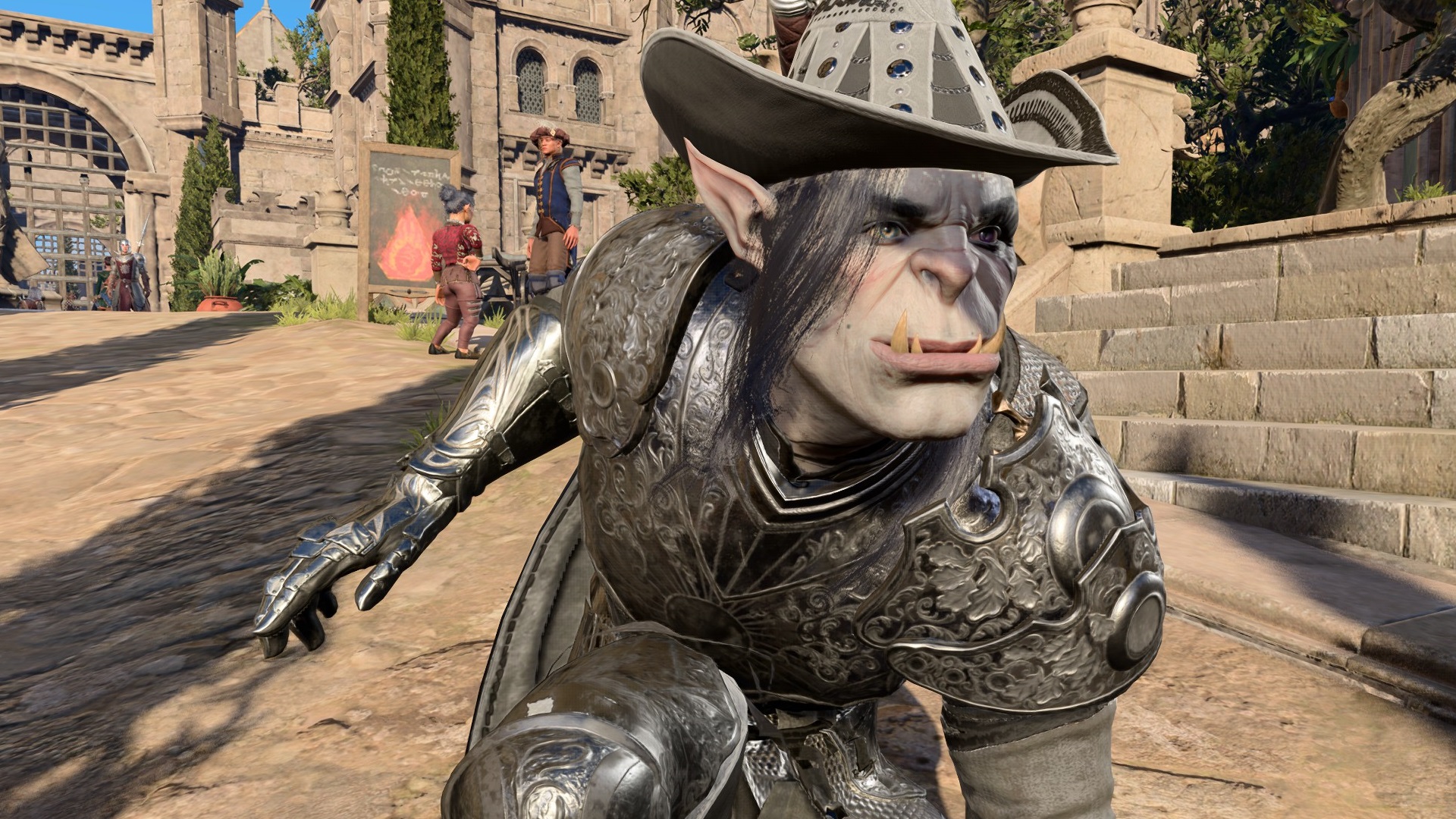
Swashbuckler 11 / Hexblade 1
I wrote a whole love letter to the Swashbuckler about how I think it's completely changed the game for Rogues in Baldur's Gate 3, but to summarize:
- Flick o' the Wrist sneakily offers an alternative to Extra Attack, and you get it a whole level earlier. This addresses the Rogue's biggest weakness, their lack of Extra Attack.
- Sneak Attacks are much easier to land, which is extremely helpful in the early game.
- Sticking with Rogue for more of the game leads to an impressively powerful 6d6 Sneak Attack per round, with the Swashbuckler's bonus action attack meaning you don't have to sacrifice actions per round to get there.
- It's an extremely fun class fantasy.
Notably, the use of Bonus Actions means you're not going to want to dual wield with this build, unless you're just using a stat stick in the offhand like Bloodthirst paired with Crimson Mischief in the endgame. The real sicko move, though, is the Dex-based, enemy-debuffing sword, Phalar Aluve, paired with the Great Weapon Master feat.
The one-level dip of Hexblade lets us consolidate into Charisma for both damage and the debuff effects of our Swashbuckler abilities. I highly recommend saving it for level five at the earliest in order to take advantage of that early game Dirty Trick power—you don't even have to respec if you don't want, since early game, a 16/17 split on Dexterity/Charisma provides the same bonuses.
Starting Stats:
- Strength: 8
- Dexterity: 16
- Constitution: 14
- Intelligence: 8
- Wisdom: 10
- Charisma: 17
Leveling Order:
- Rogue 1 - Sneak Attack +1d6
- Rogue 2
- Swashbuckler 3 - Rakish Audacity, Sneak Atk +2d6
- Swash 4 - Dirty Tricks, Feat: Cha +2
- Hexblade 1
- Swash 5 - Sneak Atk +3d6
- Swash 6
- Swash 7 - Sneak Atk +4d6
- Swash 8 - Savage Attacker OR Alert
- Swash 9 - Panache, Sneak Atk + 5d6
- Swash 10
- Swash 11 - Sneak Atk + 6d6
Act 1 Items
- Ring of Protection
- Spidersilk Armour
- Caustic Band
- Bow of Awareness
- Phalar Aluve
- Auntie Ethel's Hair
- Disintegrating Night Walkers
Act 2 Items
Act 3 Items
Patch 8 Build: Giant Barbarian Rainbow Thrower

Giant Barbarian 10 / Fighter 2
It seems a real tossup whether Giant Barbarians make for better throwing weapon builds than Berserkers, but I'm definitely finding them more fun. Elemental Cleaver means anything can be a throwing weapon, seriously opening up your options.
For this build, I'm opting of multiple sources of elemental damage and paired debuffs: Mourning Frost cold damage and the Snowburst Ring for slippery surfaces knocking enemies prone, and Elemental Cleaver Lightning/Thunder damage plus the Gloves of Belligerent Skies for powerful Reverberation debuffs.
You also get the very fun Giant's Kick ability on bonus actions, and Fighter's Action Surge will help you keep flinging all day long.
Starting Stats:
- Str: 17
- Dex: 14
- Con: 16
- Int: 8
- Wis: 10
- Cha: 8
Leveling Order:
- Barbarian 1
- Barbarian 2
- Giant 3
- Giant 4, Feat: Tavern Brawler Str +1
- Giant 5, Extra Attack, Boot of the Giants
- Giant 6, Elemental Cleaver
- Giant 7
- Giant 8, Feat: Strength +2
- Giant 9
- Giant 10, Mighty Impel
- Fighter 1
- Fighter 2, Action Surge
Act 1 Items:
- Returning Pike (pre-level 6)
- Ring of Flinging
- Gloves of Belligerent Skies
- Mourning Frost
- Boots of Stormy Clamour
Act 2 Items
Act 3 Items
Circle of Stars Spirit Guardians Death Cleric
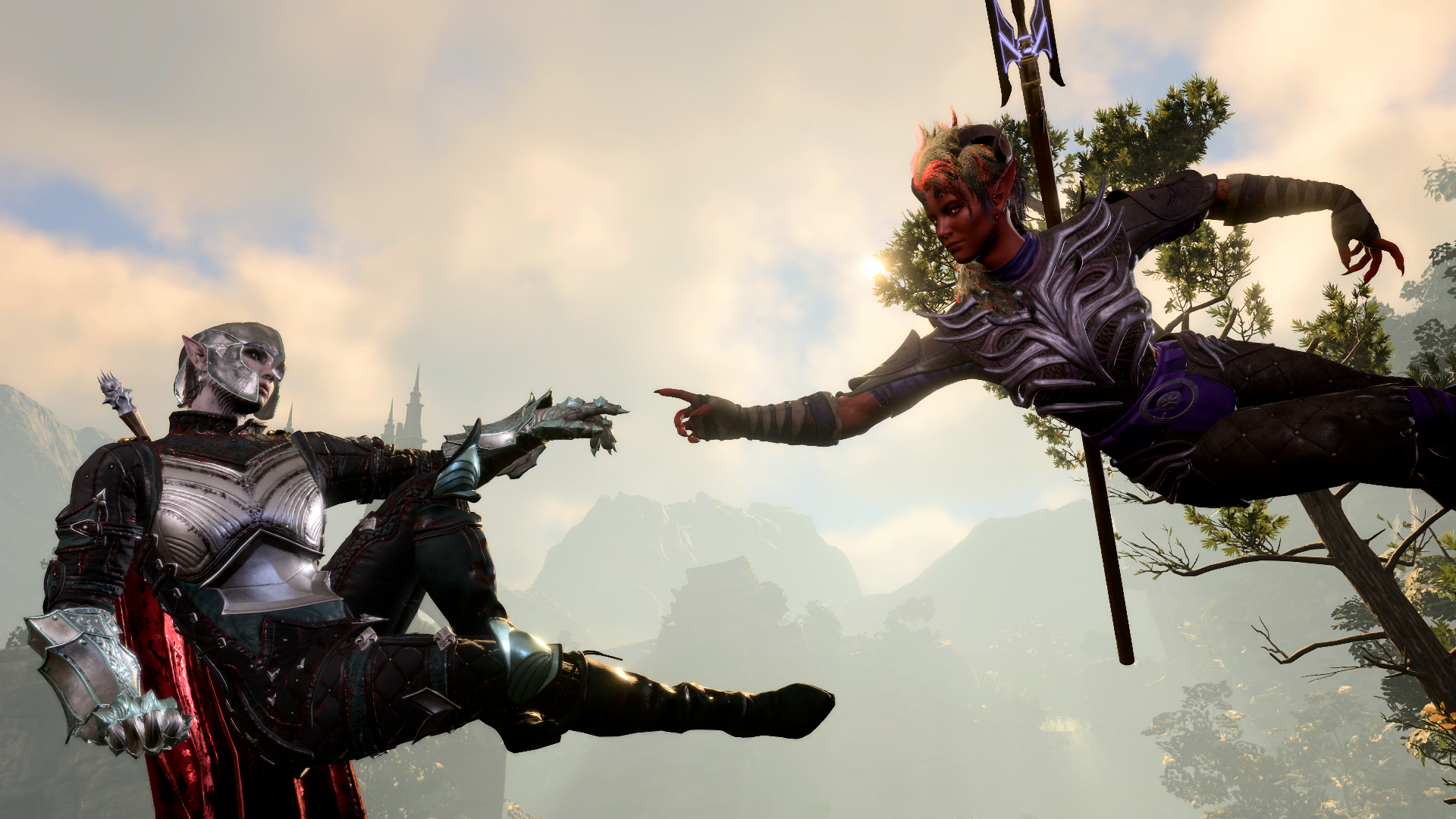
Death Cleric 10 / Circle of Stars Druid 2
Hexblade is the best one-level dip in BG3, but Circle of Stars is probably tied with Fighter as the best two-level dip, at least for a dedicated spellcaster. Playing a Wizard or Sorcerer? Archer Form gives you something to do from afar with your bonus actions.
For a more up-close caster, like a Cleric, Dragon Form provides a huge bonus to concentration rolls, as well as a bonus action 2d6 Radiant damage AOE. It's basically tailor-made for Spirit Guardian-focused Clerics.
We'll still be casting the Radiant damage version, even as a Death Cleric, but we can still have some fun with necro spells like Inflict Wounds and Toll the Bell. Stack Radiant and Reverberation gear for a walking AOE wrecking ball.
Starting Stats:
- Str: 8
- Dex: 16
- Con: 15
- Int: 8
- Wis: 17
- Cha: 8
Leveling order:
- Death Cleric 1
- Cleric 2
- Cleric 3
- Cleric 4, Feat: Wis +1, Con +1
- Cleric 5
- Cleric 6
- Cleric 7
- Cleric 8, Feat: Wis +2 or War Caster
- Cleric 9
- Cleric 10
- Circle of Stars 1
- Circle of Stars 2, Starry Form
Act 1 Items
- Boots of Stormy Clamour
- Luminous Armour
- Blood of Lathander
- Adamantine Shield
- Ring of Protection
- Gloves of Belligerent Skies
- Disintegrating Nightwalkers
Act 2 Items
Act 3 Items
Sorcerer Paladin (Sorcadin)
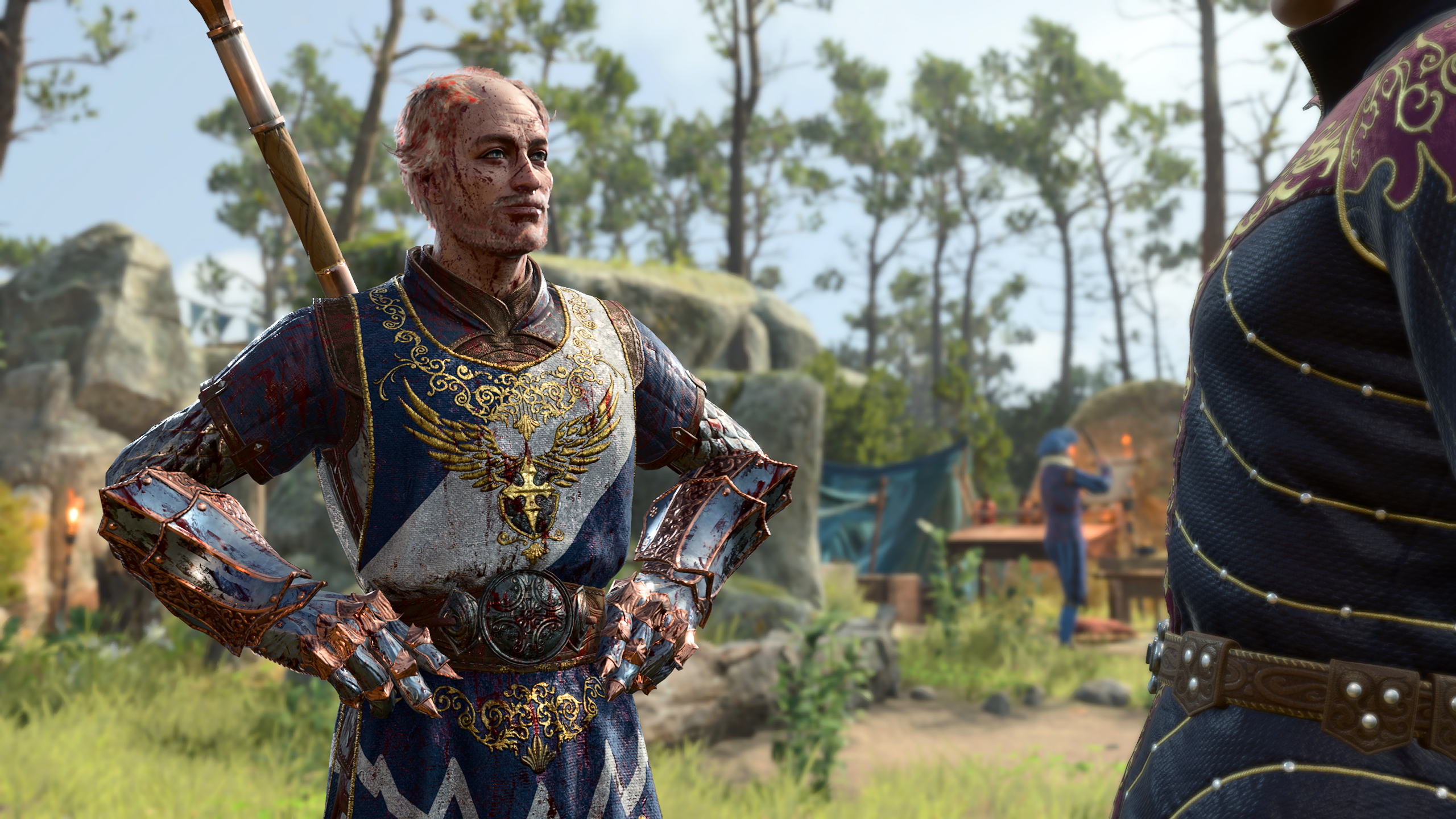
Devotion Paladin 6 / Sorcerer 6 👼️
It's a relatively simple concept: pair Paladin with a Charisma caster like Bard, Sorcerer, or Warlock to take advantage of their combat buffs and, more importantly, their ample Spell Slots to go smiting all the live-long day. Prolific Divinity: Original Sin 2 guide maker sin tee has a great guide to Sorcadins, and here's that build taking on the most challenging fight in the game on Tactician (spoilers).
This Strength-based spellsword is how I plan on going through Honour mode next. For the first half of the game, you're basically just playing as a straight-up Paladin. Oath of Devotion is great because their Sacred Weapon ability makes them one of the best two hand weapon classes in the early game. Great Weapon Master's +10 damage is game changing, particularly early on, but that -5 to attack is hard to mitigate in Act 1. Sacred Weapon's Charisma bonus to attack goes a long way to fixing that. In Act 2, the Gloves of the Automaton's 10-round attack advantage buff basically eliminates this penalty, and you can just swap them on to apply the buff, then take them off.
Otherwise, the Gloves of Dexterity will help you overcome the build's poor initiative, and there's a host of strong two-handed weapons you can use throughout the game until you get the late game dinger, Balduran's Giantslayer. This is a great build for your main character, as its Charisma focus can help with dialogue checks. You'll want to use most of your spell slots for smites, but arcane buffs like Haste are great for a front liner like this, while it won't hurt to have some nukes and crowd control spells for certain situations.
Recommended Skills: Persuade, Religion, Athletics
Starting Stats:
- Strength: 17
- Dexterity: 8
- Constitution: 14
- Intelligence: 8
- Wisdom: 10
- Charisma: 16
Leveling Order:
- Paladin 1
- Paladin 2 - Divine Smite, Great Weapon Fighting
- Paladin 3 - Divine Health
- Paladin 4 - Great Weapon Master
- Paladin 5 - Extra Attack
- Paladin 6- Aura of Protection
- Sorcerer 1
- Sorcerer 2
- Sorcerer 3
- Sorcerer 4 - ASI +2 Charisma or Strength
- Sorcerer 5
- Sorcerer 6
Notable Gear:
- Everburn Blade (Nautiloid Prologue)
- Sword of Justice (Act 1 - Our Fiery Friend)
- Auntie Ethel's Hair (Act 1 - Save Mayrina)
- Caustic Band (Act 1 - Myconid Colony Dwarf vendor)
- Strange Conduit Ring (Act 1 - Creche Y'llek Inquisitor's Chamber)
- Gloves of Dexterity (Act 1 - Creche Y'llek merchant)
- Ring of Protection (Act 1 - Steal the Idol for Mol)
- Adamantine Splint Mail (Act 1 - Grymforge)
- Halberd of Vigilance (Act 2 - Moonrise Towers, Lann Tarv)
- Dwarven Splintmail (Act 2 - Moonrise Towers, Lann Tarv)
- Evasive Shoes (Act 2 - Last Light, Mattis)
- Cloak of Protection (Act 2 - Last Light, Quartermaster Talli)
- Gloves of the Automaton (Act 2 - Last Light, Barcus Wroot)
- Potion of Everlasting Vigour (Act 2 - Moonrise Towers, Araj Oblodra)
- Armour of Persistence (Act 3 - Dammon's Smithy, Lower City)
- Balduran's Giantslayer (Act 3 - The Blade of Frontiers)
- Birthright (Act 3 - Sorcerous Sundries)
- Amulet of Greater Health (Act 3 - House of Hope)
- Sarevok's Helmet (Act 3 - Investigate the Murders)
Hand Crossbow Gunslinger Bard

College of Swords Bard 6 / Thief Rogue 3 / Champion Fighter 3 🔫
I was in love ever since I saw variations of this build from cRPG Bro and Mordarim on YouTube, and I used it to great effect in my first Honour Mode run. It takes advantage of the College of Swords Slashing Grace ability, which lets you spend a Bardic Inspiration to make two attacks (with bonus damage!) for the price of one. There are melee and ranged versions of Slashing Grace, but the melee one is a more limited AOE, while the ranged attack lets you attack any two targets, or even double up on the same one. Check out build crafter Sin Tee using a similar build to solo a challenging mid-game fight.

Baldur's Gate 3 guide: Everything you need
Baldur's Gate 3 tips: Be prepared
Baldur's Gate 3 classes: Which to choose
Baldur's Gate 3 multiclass builds: Coolest combos
Baldur's Gate 3 romance: Who to pursue
Baldur's Gate 3 co-op: How multiplayer works
Combine that with dual wielding, the Fighter's Action Surge, and the Thief's Fast Hands second bonus action (meaning an extra offhand attack for a dual wielder), and maybe a Haste spell for good measure, and you've got a character with among the highest potential attacks per round in the game.
Hand Crossbows really benefit from the Sharpshooter feat. Like Great Weapon Master, this grants you +10 to damage at the expense of -5 to your attack roll accuracy. Hand Crossbows are the only dual wieldable weapon in the game that can benefit from this sort of bonus, making them a quiet powerhouse.
Sharpshooter's much harder to use early on due to that accuracy penalty. For most of the first act I was toggling it on and off pretty regularly depending on enemy AC and what attack roll bonuses I could get. Spells like Bless definitely help, but I found Faerie Fire a real game changer—it gives you advantage on attack rolls against any enemies caught in the spell, effectively negating the Sharpshooter penalty. On Honour Mode especially though, this character's capacity for talking their way out of conflict will be a real boon in the early game.
This build's a bit of a glass cannon, especially with the Risky Ring that helps fully quash the Sharpshooter accuracy penalty—I always try to go for a beastly first round ambush with this character, with plenty of Potions of Invisibility in reserve for if I'm caught out.
I considered taking four levels of Thief for a second feat, but I prefer getting that third fighter level for the Champion's Improved Critical Hit. With the right gear and Elixirs of Bloodlust, I was able to get a critical range of 15-20 by the end of the game. I reached 18 Dexterity thanks to Auntie Ethel's Hair, and hit 20 Dex for much of the midgame with The Graceful Cloth, achieving a gear-free 20 early in Act 3 by using the Mirror of Loss accessible at the end of Shadowheart's personal quest.
Recommended Skills: Persuade, Intimidate, Perform, Sleight of Hand
Starting Stats:
- Strength: 8
- Dexterity: 17
- Constitution: 14
- Intelligence: 8
- Wisdom: 10
- Charisma: 16
Leveling Order:
- Bard 1
- Bard 2
- Bard 3- College of Swords, Dual Wield Combat Style
- Bard 4 - Sharpshooter
- Bard 5
- Bard 6 - Extra Attack
- Rogue 1 - Sneak Attack
- Rogue 2
- Rogue 3 - Thief, Fast Hands
- Fighter 1 - Archery Combat Style
- Fighter 2 - Action Surge
- Fighter 3 - Champion, Improved Critical Hit
Notable Gear:
- Gloves of Archery (Act 1 - Grat the Trader, Goblin Camp)
- Hand Crossbow +1 (Act 1 - Occasionally sold by Dammon)
- Auntie Ethel's Hair (Act 1 - Save Mayrina)
- Caustic Band (Act 1 - Myconid Colony Dwarf Trader)
- Knife of the Undermountain King (Act 1 - Creche Y'llek Trader)
- Strange Conduit Ring (Act 1 - Creche Y'llek, use with the Ability Improvement spell for a fire-and-forget 1d4 damage bonus)
- Risky Ring (Act 2 - Araj Oblodra, Moonrise Towers)
- Hellfire Hand Crossbow (Act 2 - defeat Yurgir, Gauntlet of Shar)
- Hand Crossbow +2 (Act 3 - Lady Jannath's Estate)
- Elegant Studded Leather (Act 3 - The Counting House)
- Fey Semblance Amulet (Act 3 - Avenge the Hag Survivors)
- Legacy of the Masters (Act 3 - Dammon, Lower City)
- Bloodthirst (Act 3 - Defeat Orin)
- Sarevok's Helmet (Act 3 - Investigate the Murders)
- Greater Amulet of Health (Act 3 - House of Hope)
- Helldusk Gloves (Act 3 - House of Hope)
Master Martial Artist

Open Hand Monk 9 / Thief Rogue 3 👊
I've been sleeping on Monks in Baldur's Gate 3—sometimes I'm really in the mood for a funky unarmored martial arts guy in D&D, but I wasn't ready for it at Baldur's Gate 3's launch. The thing is, Open Hand Monks might be one of the straight-up strongest classes in the game. Here's Divinity/BG3 buildsmith sin tee taking on the hardest boss of Act One with a solo level 7 Open Hand Monk as an example.
Monks have three real knockouts on offer: Flurry of Blows, Manifestation, and the Tavern Brawler feat. Flurry of Blows is an insane ability, giving you two full unarmed attacks for the price of one Bonus Action. Open Hand Monks get further variations on Flurry of Blows, but basically from level one Monks are able to attack three times per round.
Manifestation of Mind, Body, or Soul is a toggleable Open Hand ability that gives you bonus unarmed damage based on your Wisdom modifier. What's more, the Boots of Uninhibited Kushigo available at the beginning of Act 3 let you add your Wisdom modifier to attacks again.
Tavern Brawler lets you double your Strength bonus on attacks, meaning a well-built Open Hand Monk will be doing double their Strength and Wisdom bonus in damage on every single attack, while attacking no less than four times a turn.
Adding in those four Thief levels gets us an extra Bonus Action (so more Flurry of Blows per round) with Fast Hands. When I use this build in my next Honour Mode run, I'm going to go for 8 Monk levels so I don't miss the excellent level 7 ability Stillness of Mind, but you can also opt for two Fighter levels and get Action Surge instead—cRPG Bro on YouTube has a Monk guide along those lines.
You might consider taking a single level of Rogue at level one or two if this is your main character, especially on Honour mode. I had a promising run of the permadeath path cut tragically short on a failed Persuasion check I wasn't prepared for, and taking a single Rogue level (and thus, Persuasion specialization) early could have helped there, at the expense of optimal combat readiness.
One power-gaming move you might consider is actually dumping your Strength stat and relying on Elixirs of Giant Strength and the Club of Hill Giant Strength. This frees you up to have higher Wisdom, Dexterity, and Constitution scores, and is how I plan on building a companion version of this build in my next playthrough.
Recommended Skills: Athletics, Insight, Persuade (at Thief levels if main character)
Starting Stats (this assumes you'll be getting a +1 to Wisdom from Auntie Ethel's Hair):
- Strength: 17
- Dexterity: 14
- Constitution: 12
- Intelligence: 8
- Wisdom: 15
- Charisma: 8
Alternate Starting Stats (relying on potions and the club):
- Strength: 8
- Dexterity: 16
- Constitution: 15
- Intelligence: 8
- Wisdom: 16
- Charisma: 8
Leveling Order:
- Monk 1
- Monk 2
- Monk 3 - Way of the Open Hand, improved Flurry of Blows
- Monk 4 - Tavern Brawler (+1 Strength or Constitution)
- Monk 5 - Extra Attack
- Monk 6 - Manifestation of Mind/Body/Soul, Wholeness of Body
- Monk 7 - Evasion, Stillness of Mind
- Monk 8 - ASI +2 Wisdom
- Monk 9 - Ki Resonance
- Rogue 1
- Rogue 2
- Rogue 3 - Thief, Fast Hands
Notable Gear:
- Ring of Protection (Act 1 - Mol, Druid's Grove)
- The Sparkly Hands (Act 1 - )
- Gloves of Cinder and Sizzle (Act 1 - Lady Esther)
- Auntie Ethel's Hair (Act 1 - Save Mayrina)
- Caustic Band (Act 1 - Underdark, Derryth Bonecloak)
- Club of Hill Giant Strength (Act 1 - Underdark Arcane Tower)
- Elixirs of Hill Giant Strength (ingredients/potions in stock at vendors, most common after level 6)
- Disintegrating Nightwalkers (Act 1 - True Soul Nere)
- Armor of Uninhibited Kushigo (Act 1 - Underdark, Find the Missing Boots)
- The Mighty Cloth (Act 2 - Harper Quartermaster)
- Gloves of Crushing (Act 2 - Moonrise Towers, Roah Moonglow)
- Cloak of Protection (Act 2 - Harper Quartermaster)
- Darkfire Shortbow (Act 2 - Dammon)
- Hat of Uninhibited Kushigo (Act 2 - Harper Quartermaster)
- Boots of Uninhibited Kushigo (Act 3 - Intro Fight)
- Vest of Soul Rejuvenation (Act 3 - Sorcerous Sundries)
- Elixirs of Cloud Giant Strength (ingredients/potions in stock at various vendors, most common after level 9)
- Fey Semblance Amulet (Act 3 - Avenge the Hag Survivors)
- Gontr Mael (Act 3 - Steel Watch Foundry)
- Gloves of Soul Catching (Act 3 - House of Hope)
Sneaky Assassin Guy Classic
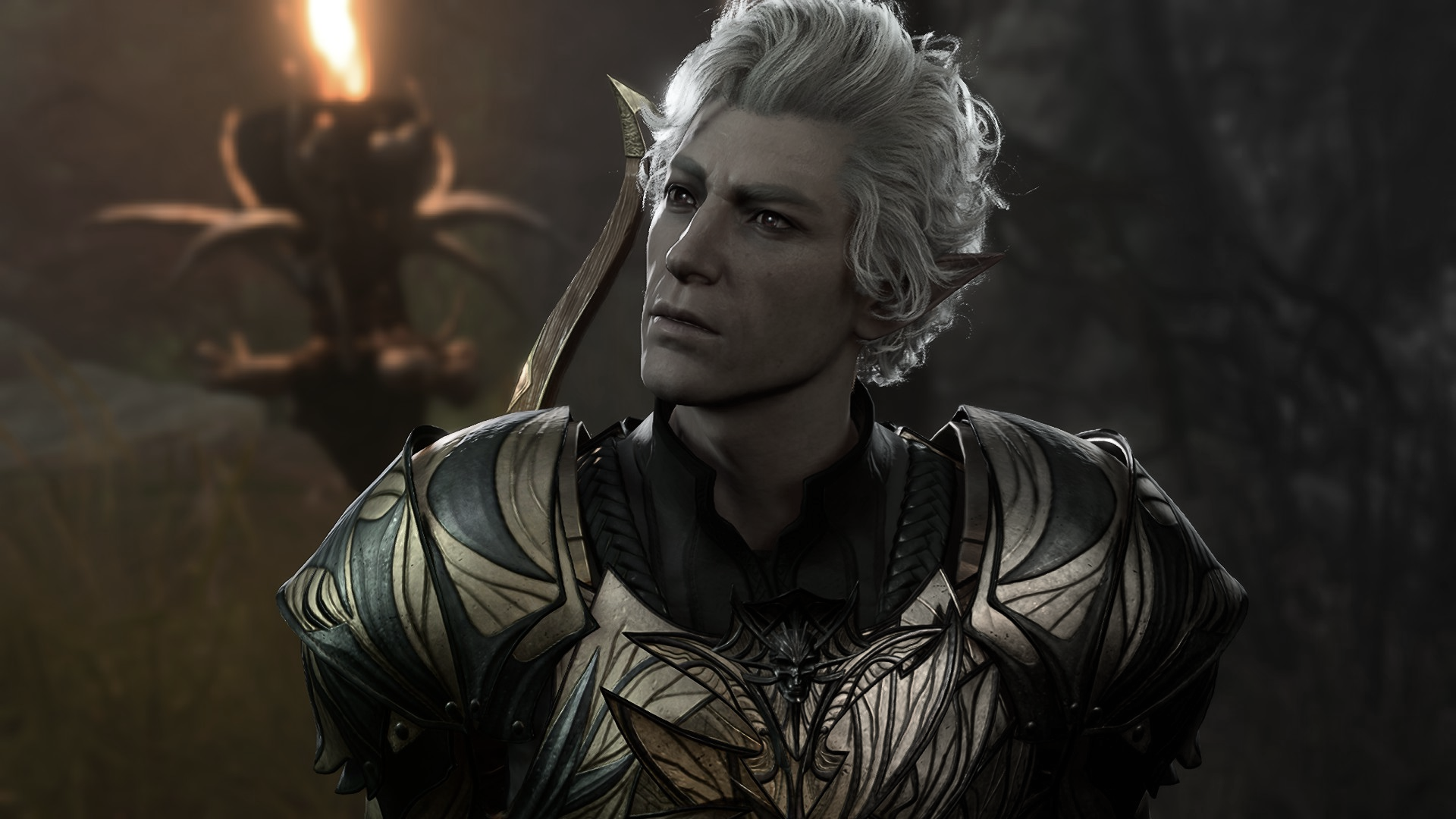
Assassin Rogue 4 / Gloom Stalker Ranger 5 / Champion Fighter 3 🥷
If, like me, you're a lover of the dual daggers RPG assassin classic, this is the way to do it in Baldur's Gate 3. You can optionally sub in the Thief specialization for Assassin, but the latter feels more on-theme and its first combat round advantages, particularly Free critical hits on surprised enemies, are incredibly powerful. Assassin also dovetails nicely with the Gloom Stalker's increased initiative and bonus first round attack.
You're not playing this build to its fullest if you don't try to begin every combat encounter you can from stealth and with a surprise round.
I like to start with a single level of Rogue to secure those nice skill specializations, especially Persuasion, which is a must in early game Honour mode. There are strong daggers and shortswords aplenty throughout the campaign, but the Knife of the Undermountain King will be your best friend for much of the game.
Being able to inflict Piercing Vulnerability from either the Bhaalist Armor or Bloodthirst dagger is a great get in the late game. The armor is slightly more "optimal," but requires you to be capital-E Evil, so all of my Chaotic Good assassins out there will want to stick with the dagger, or potentially grab a mod that makes it more available.
Recommended skills: Persuasion, Sleight of Hand
Starting stats:
- Strength: 8
- Dexterity: 17 (16 if you don't plan on using Auntie Ethel's Hair)
- Constitution: 14
- Intelligence: 8
- Wisdom: 10
- Charisma: 16
Leveling Order:
- Rogue 1
- Ranger 1
- Ranger 2, Two Weapon Fighting Style
- Ranger 3, Gloom Stalker
- Ranger 4, +2 Dexterity
- Ranger 5, Extra Attack
- Rogue 2
- Rogue 3, Assassin
- Rogue 4, Alert
- Fighter 1, Defence or Archery Fighting Style
- Fighter 2, Action Surge
- Fighter 3, Champion
Notable Gear:
- Auntie Ethel's Hair (Act 1 - Save Mayrina)
- Caustic Band (Act 1 - Myconid Colony Dwarf Trader)
- Knife of the Undermountain King (Act 1 - Creche Y'llek Trader)
- Yuan-Ti Scale Mail (Act 2 - Quartermaster Talli)
- Elegant Studded Leather (Act 3 - The Counting House)
- Legacy of the Masters (Act 3 - Dammon, Lower City)
- Armour of Agility (Act 3 - Stormshore Armoury)
- Bloodthirst (Act 3 - Defeat Orin)
- Crimson Mischief (Act 3 - Defeat Orin)
- Sarevok's Helmet (Act 3 - Investigate the Murders)
- Bhaalist Armor (Act 3 - Impress the Murder Tribunal)
- Greater Amulet of Health (Act 3 - House of Hope)
- Helldusk Gloves (Act 3 - House of Hope)
Blackguard Warlock Smiter
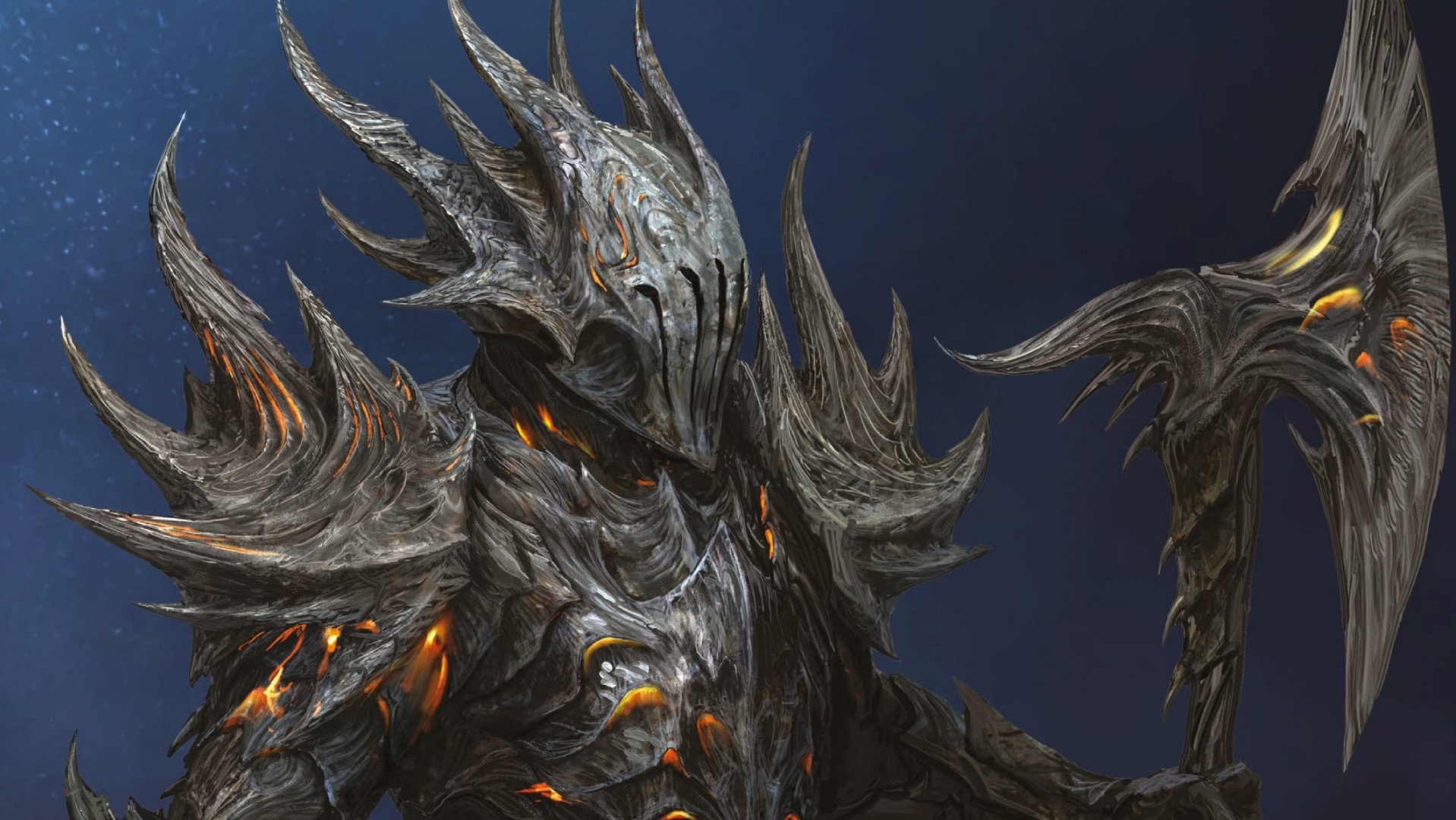
Oathbreaker Paladin 7 / Pact of the Fiend Warlock 5 👿
A Paladin with some edge, or a full-on evil dark knight in the vein of AD&D's Anti-Paladins or 3E D&D's Blackguard prestige class. Pairs Warlock short rest spell slots with Divine Smite and both classes' ample debuffs. Warlocks' Pact of the Blade specialization (chosen at level 3) also gives a Pact Weapon Extra Attack per round that stacks with martial class' normal Extra Attack, giving Martial/Warlock mutliclasses three attacks per round before even considering something like the Haste spell. Unfortunately, this build is slightly nerfed in Honour mode, with the Warlock and normal Extra Attacks no longer stacking as they do in other modes.
These guides from Mortismal Gaming and cRPG Bro on YouTube cover similar characters. Until you get Pact of the Blade, this build's ample Dexterity will let you use finesse weapons effectively, and throughout the game a high Dexterity will help with Initiative so you have a high chance of attacking first in a combat encounter.
This build could also benefit from a dip into Fighter for Action Surge, but I like going for the seven levels of Oathbreaker for Aura of Hate, which means you'll do double your Charisma bonus on damage rolls. CRPG Bro's build further builds on this with the Gauntlets of Hill Giant Strength paired with Balduran's Giantslayer. This effectively means you add your Charisma bonus twice and Strength once to every damage roll.
This build's leveling order is slightly sub optimal as presented, which avoids a respec. You could alternately play through the game up to level 7 as a pure Warlock or Paladin, then respec, though that would require you to break your paladin oath, retake it, then break it again.
Recommended skills: Persuasion, Intimidate, Athletics
Starting Stats:
- Strength: 8
- Dexterity: 16
- Constitution: 14
- Intelligence: 8
- Wisdom: 10
- Charisma: 17
Leveling Order:
- Paladin 1
- Paladin 2 - Divine Smite
- Warlock 1
- Warlock 2
- Warlock 3 - Pact of the Blade (Charisma bonus to attack and damage)
- Warlock 4 - ASI - +2 Charisma OR Great Weapon Fighting
- Warlock 5 - Blade Pact Extra Attack
- Paladin 3
- Paladin 4 - ASI +2 Charisma OR Polearm Master (if using Hellbeard Halberd)
- Paladin 5 - Extra Attack
- Paladin 6
- Paladin 7 - Aura of Hate
Notable Gear:
- Sword of Justice (Act 1 - Our Fiery Friend)
- Auntie Ethel's Hair (Act 1 - Save Mayrina)
- Caustic Band (Act 1 - Myconid Colony Dwarf vendor)
- Adamantine Splint Mail (Act 1 - Grymforge)
- Charge-Bound Warhammer (Act 2 - Dammon's Smithy)
- Reaper's Embrace (Act 2 - Final boss)
- Armour of Persistence (Act 3 - Dammon's Smithy, Lower City)
- Legacy of the Masters (Act 3 - Dammon, Lower City)
- Hellbeard Halberd (Act 3 - Devil's Fee Special Stock, Lower City)
- Sword of Chaos (Act 3 - Investigate the Murders)
- Birthright (Act 3 - Sorcerous Sundries)
- Balduran's Giantslayer (Act 3 - Under Wyrm's Rock *best paired with Gauntlets of Hill Giant Strength)
- Gauntlets of Hill Giant Strength (Act 3 - House of Hope *If using Balduran's Giantslayer)
Paladin Batman
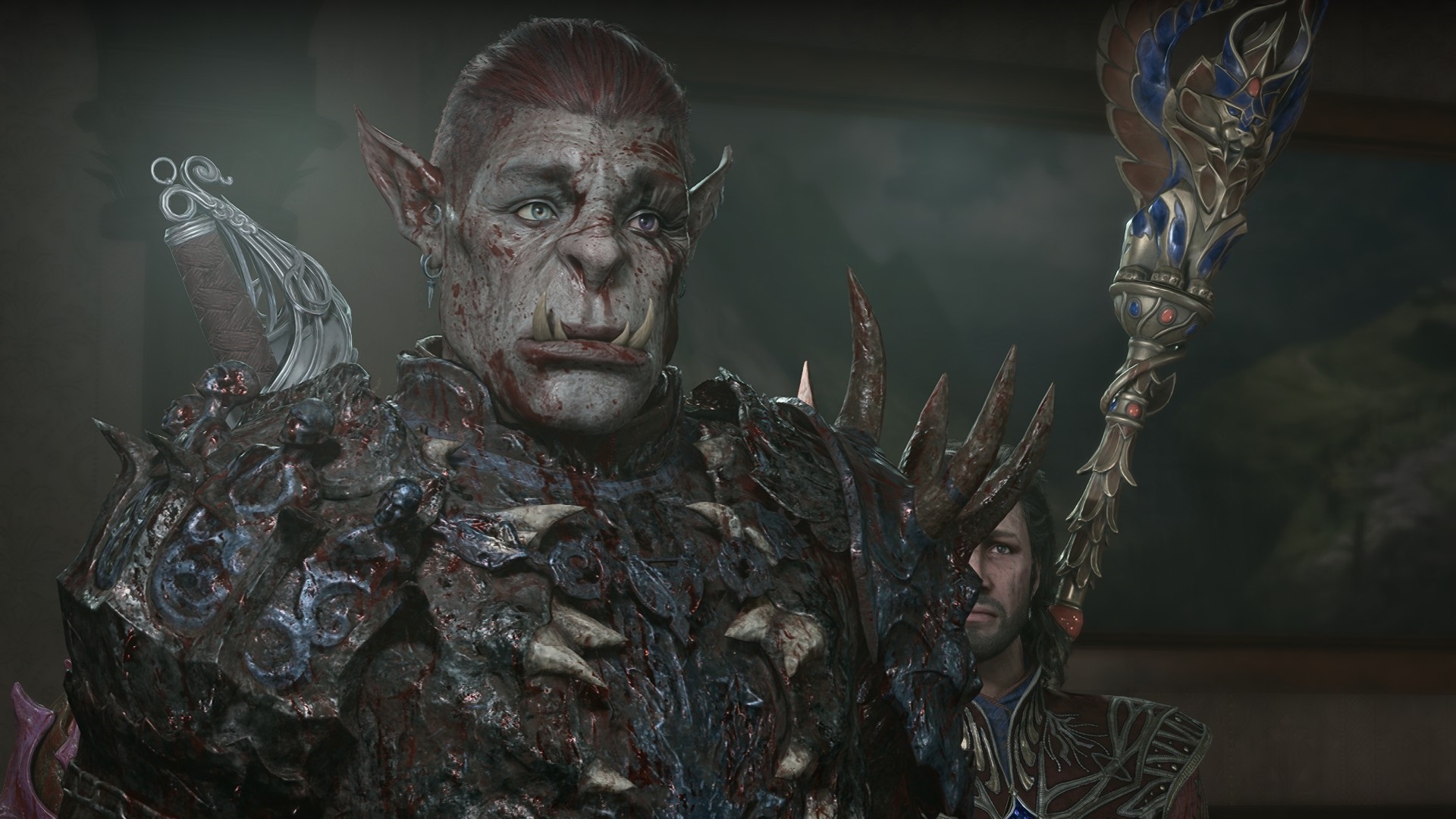
Oath of Vengeance Paladin 5 / Thief or Assassin Rogue 4 / Champion Fighter 3 🌚🗡️
Paladin's got one slight disadvantage over its Baldur's Gate 3 brethren—it's pretty slow. Unless you want to sacrifice one of your spell slots (those are for smiting, anyway) you can be left feeling like you're dragging your feet. Now introducing: the Paladin Batman build!
You trade off your spell slot progression, meaning your Divine Smites will be a touch less meaty, but Sneak Attack doesn't require a spell slot—so what you trade out burst damage you make up for in sustainability. The real star of the show here is Cunning Action: Dash, Disengage, and Hide. Being able to double your speed as a bonus action, for free, forever? It's good on any class, but especially Paladin, considering how pigeon-holed they are into melee.
This build can either be angled toward a Thief, with a focus on dual wielding, or an Assassin, with the dueling combat style and a finesse weapon with a shield. The only downside to a Thief and dual wielding is that you can't unlock the Dual Wielding Combat Style until your first Fighter level very late in the game.
Recommended Skills: Sleight of Hand, Persuade
Starting Attributes:
- Strength: 8
- Dexterity: 17
- Constitution:14
- Intelligence: 8
- Wisdom: 10
- Charisma: 16
Leveling Order:
- Paladin 1 - Dueling Combat Style or Defense Combat Style
- Rogue 1
- Paladin 2
- Paladin 3
- Paladin 4 - Dexterity +2
- Paladin 5
- Rogue 2
- Rogue 3 - Assassin or Thief
- Rogue 4 - Charisma + 2 OR Dual Wielder
- Fighter 1 - Defense Combat Style or Dual Wielding Combat Style
- Fighter 2 - Action Surge
- Fighter 3 - Champion
Recommended Gear:
- Auntie Ethel's Hair (Act 1 - Save Mayrina)
- Caustic Band (Act 1 - Myconid Colony Dwarf Trader)
- Knife of the Undermountain King (Act 1 - Creche Y'llek Trader)
- Yuan-Ti Scale Mail (Act 2 - Harper Quartermaster)
- Flawed Helldusk Gloves (Act 2 - Bring Dammon Infernal Iron)
- Duellist's Prerogative (Act 3 - Save Vanra)
- Legacy of the Masters (Act 3 - Dammon, Lower City)
- Armor of Agility (Act 3 - Stormshore Armoury)
- Bloodthirst (Act 3 - Defeat Orin)
- Helldusk Armour (Act 3 - House of Hope)
- Sarevok's Helmet (Act 3 - Investigate the Murders)
Olympic Shotputter Barbarian
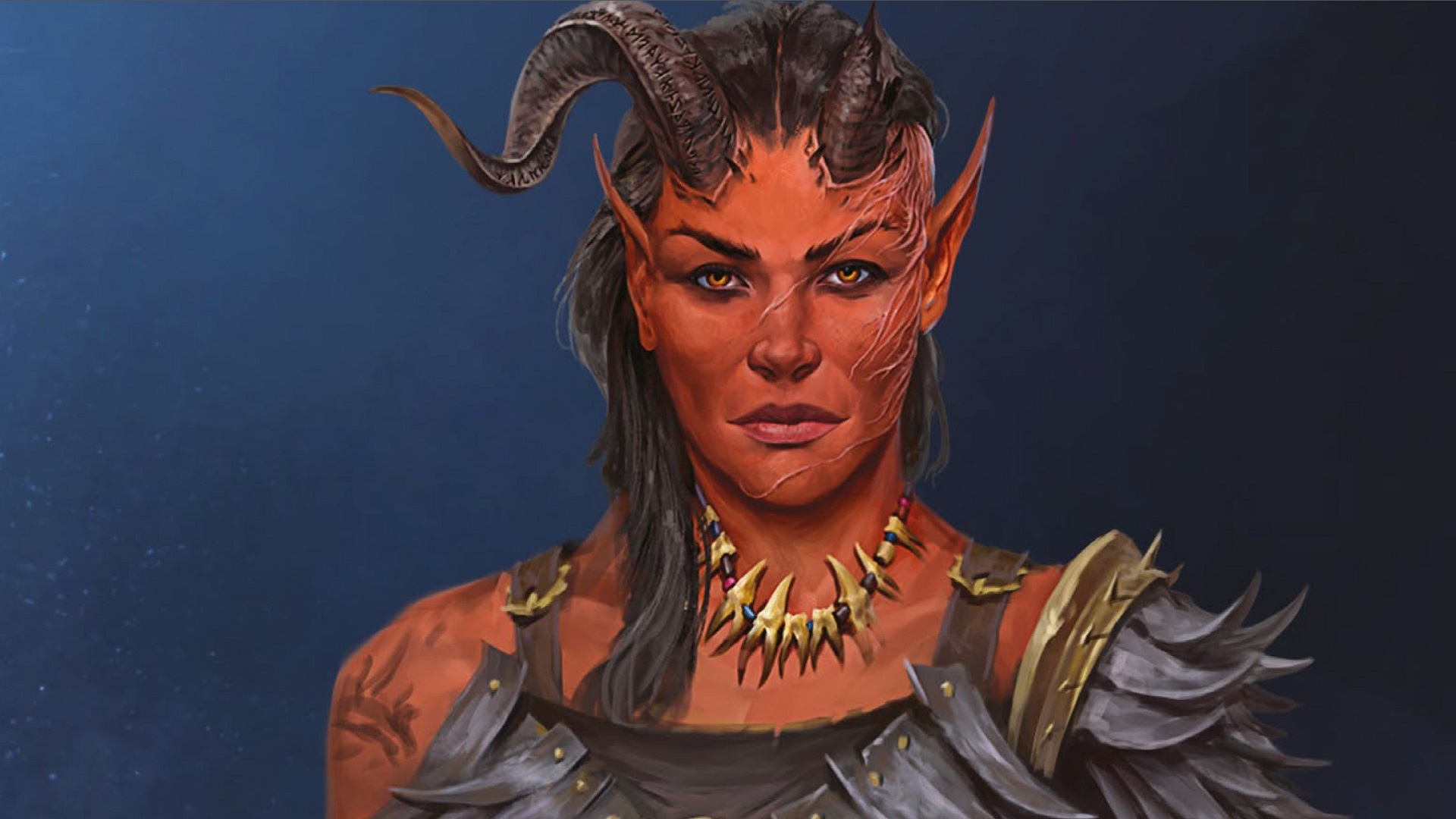
Berserker Barbarian 5 / Thief Rogue 4 / Champion Fighter 3🪓💪😤
Berserkers are just strong no matter how you slice them, but few RPGs have throwing weapons as insanely strong as Baldur's Gate 3, so it'd be a damn shame not to take advantage. 'Zerkers get Bonus Action throws while using their Barbarian Rage, and the Thief subclass gives you an extra Bonus Action—that's a no brainer combo.
Add in a surprising number of feats and items to improve thrown weapon damage, as well as a few notable weapons that return to your hand every time you throw them, and you've got a unique character who's crazy strong and that you can only really make in Baldur's Gate 3. Sin tee and cRPG Bro have great breakdowns of this sort of character, and this build is basically tailor-made for Karlach.
Also note: you can just swap out the equipment and the Tavern Brawler feat and still have a beastly melee damage dealer. If you're playing your 'zerker as a thrower, though, I'd recommend going weapon and shield with Nyrulna in the endgame—two handing it won't give you bonus damage. Nyrulna is one of my favorite weapons in BG3, and this build's endgame pick, but its friendly fire splash damage means it's good to have backup options. The two Lightning Jabbers you can find in Act 2 are a good non-returning option, and you can also buy the Dwarven Thrower right around the time you can get Nyrulna—just remember to talk to Ferg Drogher without Shadowheart if you're on her good path.
Recommended Skills: lol, Athletics I guess?
Starting Stats:
- Strength: 17
- Dexterity: 14
- Constitution: 16
- Intelligence: 8
- Wisdom: 10
- Charisma: 8
Leveling Order:
- Barbarian 1
- Barbarian 2
- Barbarian 3 - Berserker
- Barbarian 4 - Tavern Brawler (+1 Strength)
- Barbarian 5 - Extra Attack
- Rogue 1
- Rogue 2
- Rogue 3 - Thief, Fast Hands
- Rogue 4 - Strength +2 or Alert
- Fighter 1
- Fighter 2 - Action Surge
- Fighter 3 - Champion
Notable Gear:
- Returning Pike (Act 1 - Grat the Trader, Goblin Camp)
- Ring of Flinging (Act 1 - Aaron, Druid's Grove)
- Gloves of Uninhibited Kushigo (Act 1 - Find the Mushroom Picker)
- Caustic Band (Act 1 - Myconid Colony Dwarf Trader)
- The Mighty Cloth (Act 2 - Harper Quartermaster)
- Lightning Jabber (Act 2 - Cursed Kuo-Toa Chief)
- Enraging Heart Garb (Act 2 - Lann Tarv, Moonrise Towers)
- Potion of Everlasting Vigour (Act 2 - Moonrise Towers, Araj Oblodra)
- Nyrulna (Act 3 - Rivington, Expose Akabi)
- Dwarven Thrower (Act 3 - Rivington, Ferg Drogher)
- Flame Enameled Armour (Act 3 - Wyrm's Rock Fortress)
- Viconia's Walking Fortress (Act 3 - House of Grief)
- Sarevok's Helmet (Act 3 - Investigate the Murders)
- Horns of the Berserker (Act 3 - Rivington, Danthelon's shop)
- Legacy of the Masters (Act 3 - Dammon, Lower City)
Swashbuckling Duelist Bardadin

Oath of Vengeance Paladin 2 / College of Swords Bard 10 🤺
This particular character from master buildsmith Sin Tee relies on the respec system—you can definitely play it straight without starting over from level 1, but I would not recommend that on Honour mode.
Basically, it's the same premise as our Sorcadin (Charisma caster spell slots with Paladin Divine Smite), but focusing on Dexterity, going all in on the Swords Bard's excellent abilities and spells, and taking advantage of one of my favorite weapons, the unique rapier Duellist's Prerogative.
For most of the game, you'll be using a finesse weapon (either Phalar Aluve or The Knife of the Undermountain King) with a shield, and for optimal, Honour-ready play, you'll actually just build your character as a pure Oath of Vengeance Paladin until they reach level 8—that's when Swords Bards can get Extra Attack after starting with two levels of Pally.
Once you snag Duellist's Prerogative, you'll want to drop the shield. Keeping your offhand empty with this rapier unlocks special abilities well worth the decreased Armor Class. Also? It helps complete the whole swashbuckler aesthetic.
One other fun thing this character can do: using a high level Bard's Magical Secrets ability, you can get access to the excellent friendly fire-proof, melee-range Cleric spell Spirit Guardians to damage and weaken any enemy you approach. This character also has access to all the skills they could want, dialogue or otherwise, while getting the unique reactions and dialogue of both the Paladin and the Bard.
Recommended Skills: Persuasion, Sleight of Hand
Starting Stats:
- Strength: 8
- Dexterity: 17 (if using Auntie Ethel's Hair)
- Constitution: 14
- Intelligence: 8
- Wisdom: 10
- Charisma: 16
Leveling order (post respec):
- Paladin 1, Oath of Vengeance
- Paladin 2, Divine Smite
- Bard 1
- Bard 2
- Bard 3, College of Swords
- Bard 4, +2 Dexterity or Savage Attacker
- Bard 5
- Bard 6, Extra Attack
- Bard 7
- Bard 8, Alert
- Bard 9
- Bard 10
Notable Gear:
- Auntie Ethel's Hair (Act 1 - Save Mayrina)
- Caustic Band (Act 1 - Myconid Colony Dwarf Trader)
- Knife of the Undermountain King (Act 1 - Creche Y'llek Trader)
- Phalar Aluve (Act 1 - Underdark)
- Strange Conduit Ring (Act 1 - Creche Y'llek, use with the Ability Improvement spell for a fire-and-forget 1d4 damage bonus)
- Adamantine Shield (Act 1 - The Grymforge)
- Yuan-Ti Scale Mail (Act 2 - Harper Quartermaster)
- Flawed Helldusk Gloves (Act 2 - Bring Dammon Infernal Iron)
- Duellist's Prerogative (Act 3 - Save Vanra)
- Legacy of the Masters (Act 3 - Dammon, Lower City)
- Armor of Agility (Act 3 - Stormshore Armoury)
- Bhaalist Armor (Act 3 - Impress the Murder Tribunal)
- Sarevok's Helmet (Act 3 - Investigate the Murders)
Ted has been thinking about PC games and bothering anyone who would listen with his thoughts on them ever since he booted up his sister's copy of Neverwinter Nights on the family computer. He is obsessed with all things CRPG and CRPG-adjacent, but has also covered esports, modding, and rare game collecting. When he's not playing or writing about games, you can find Ted lifting weights on his back porch.
- Harvey RandallStaff Writer
You must confirm your public display name before commenting
Please logout and then login again, you will then be prompted to enter your display name.

